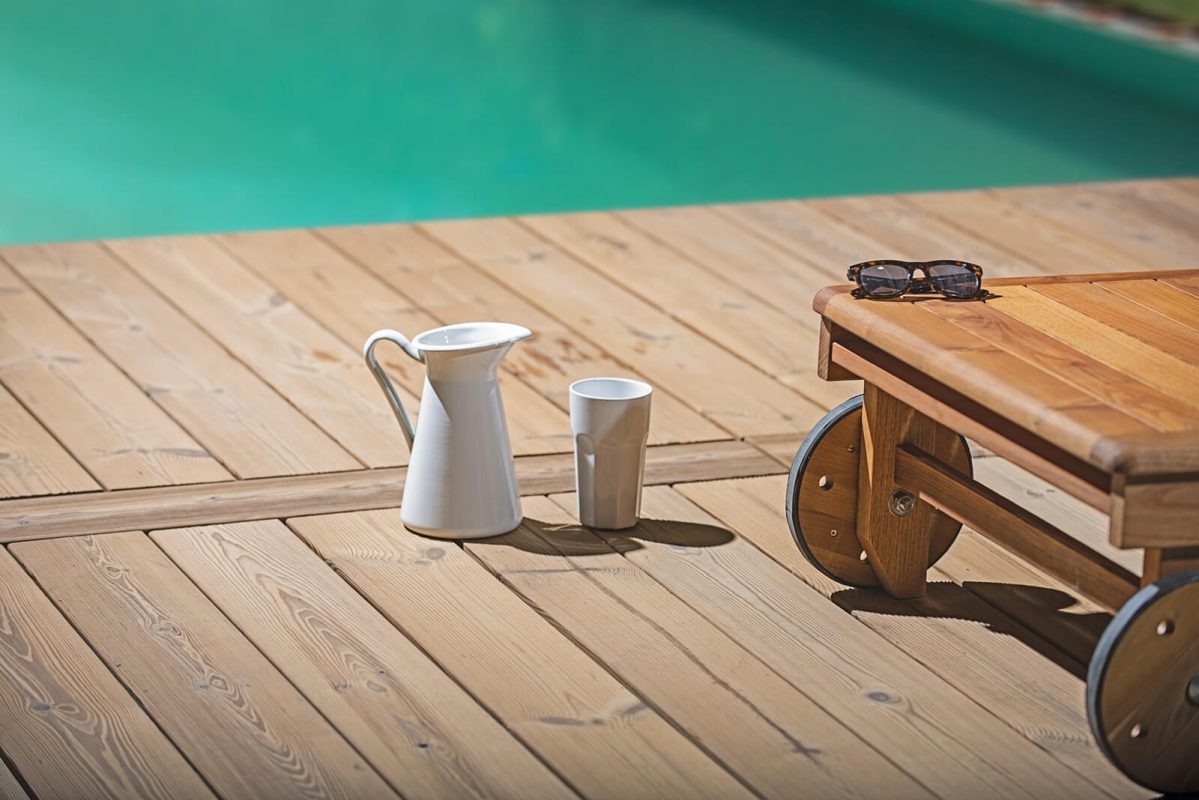The thermal insulation properties of thermowood are approximately one-fourth higher than that of untreated wood. This is reflected in the low energy consumption: much less thermal energy is consumed in cold weather, while hot air requires less air conditioning in rooms where thermowood was used. Heat treated timber have a warm spirits, is non-toxic, environmentally friendly and recyclable product that can be disposed of at the end of its life for incineration or buried with other waste.
Durability class for thermowood
Thermowood (Thermo-D) belongs to durability class 2, which has a predicted service life of 30+ years, when mold resistance is assessed (BRE-certificate). This applies to facade cladding and decking boards. The decking boards have usually the surface that is used frequently, which reduces the typical expected service life of these products to 15-20 years. After the heat treatment process, the moisture content of the thermowood is 5% (+/- 1%). When the thermowood is used outdoors (+ 20º C, RH 65%), the moisture content of heat-treated Thermo-D pine wood stabilizes at 6.5% (EN 13183).
- Fire resistance class
The fire resistance class of thermowood is the same as that of conventional wood D-s1-d0. In cases where a higher degree of fire resistance is required, heat treated wood can be treated with the same fire protection products as normal wood. Always follow the instructions provided by the fire retardant manufacturer.
- Thermowood installation
When constructing a deck, it is always recommended to raise the decking at least 30-50 mm above the ground to allow air circulation. The space between the boards should be at least 5-6 mm to provide air ventilation and ensure rainwater drainage. Any gap near the joint wall should be at least 5 mm and the gap between the two ends of the boards should be a minimum of 2-3 mm. When fixing outdoor siding, a ventilation gap between the boards and the wall (22-25 mm) must be provided. Please also note that there should be a clearance of at least 30 cm between the ground and the lowest edge of the siding.
- Thermowood fastening
Heat treatment makes the wood slightly more prone to cleave. For this reason, it is recommended to use tapping screws or pre-drilled holes. The screws must be stainless steel and suitable for fixing the wood. When nails are used, they should be positioned at least 2 cm from the board edge or in pre-drilled holes. When using a conventional hammer, it is advisable to use a nailer for the remaining 2-3 mm. Cladding and siding boards should be fixed using pre-drilled holes from the top of the grooves so that the screw is screwed or the nail is inclined at less than 40 degrees. Small pneumatic nailer tools can achieve good results. However, the pressure must be adjusted so that the nails are not inserted too deep into the wood.
- Thermowood planing
Thermowood products can be planed with conventional planing tools or automatic planing machines. Planing of thermowood products gives the products a special quality surface. The planing tools (blades) must be selected according to the type of hard wood. Raw materials can be convex after heat treatment, so the feeder cylinder for automatic planing machines should be adapted to help prevent the boards from cracking.
- Thermowood sanding
You may not need sanding the thermowood products as the surface quality is truly excellent after factory milling and grinding. However, if the thermowood is additionally sanded, the sanding paper will stay even longer and in perfect shape, since the thermowood does not have resin.
- Thermowood milling
If thermowood should be milled, the blade must be well prepared and sharp to ensure good end results. Fine milling dust is instantly removed and does not stick to the cutting blade.
- Thermowood bonding
Heat treated wood can be glued. However, bonding of heat treated wood can take 4-6 times longer compared to untreated wood. Always follow the adhesive manufacturer’s instructions.
- Thermowood sawing
Thermowood is as easy to cut as conventional wood. However, the saw blade should be sharp, the circular saw blade should be fine and the wood should be fed slowly.
- Thermowood coating
Thermowood products can have two different surfaces: smooth and rough. The rough surface must be painted, as the wood rough allows the paint to adhere to the surface.
- Thermowood bending resistance
The flexural properties of thermowood (Thermo-D) are slightly reduced. Therefore, it is recommended that thermowood products should not be used in the structure of high-pressure, load-bearing structures and partitions without additional support; or resistance calculations must be performed on a case-by-case basis.
Fasteners for thermowood
Fasteners made of stainless steel or acid-resistant steel should be used outdoors and in wet areas to prevent rust and oxidation of the thermowood. Galvanized fasteners are suitable for dry rooms. Galvanized screws (nails) are suitable for reinforcing exterior furniture if the boards are painted even before screwing. When using screws, it is recommended to use a wide thread. When the nail or screw is fixed close to the edge, it is recommended that you drill holes beforehand as this will help prevent cracks. Baseboards should be fastened by pre-drilling holes from the top, so that the screw or thin nail is hammered at an angle of less than 40º. We recommend the use of small pneumatic nailers, making sure that the hole is only forged to the length of the nail. Using a conventional hammer, use a 2-3 mm nailer together.

